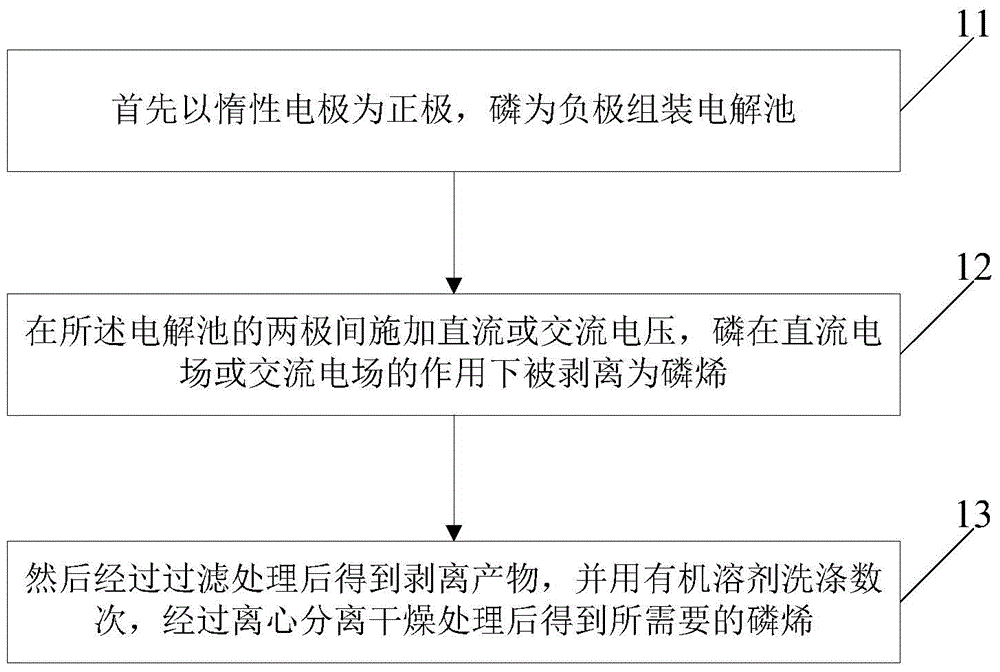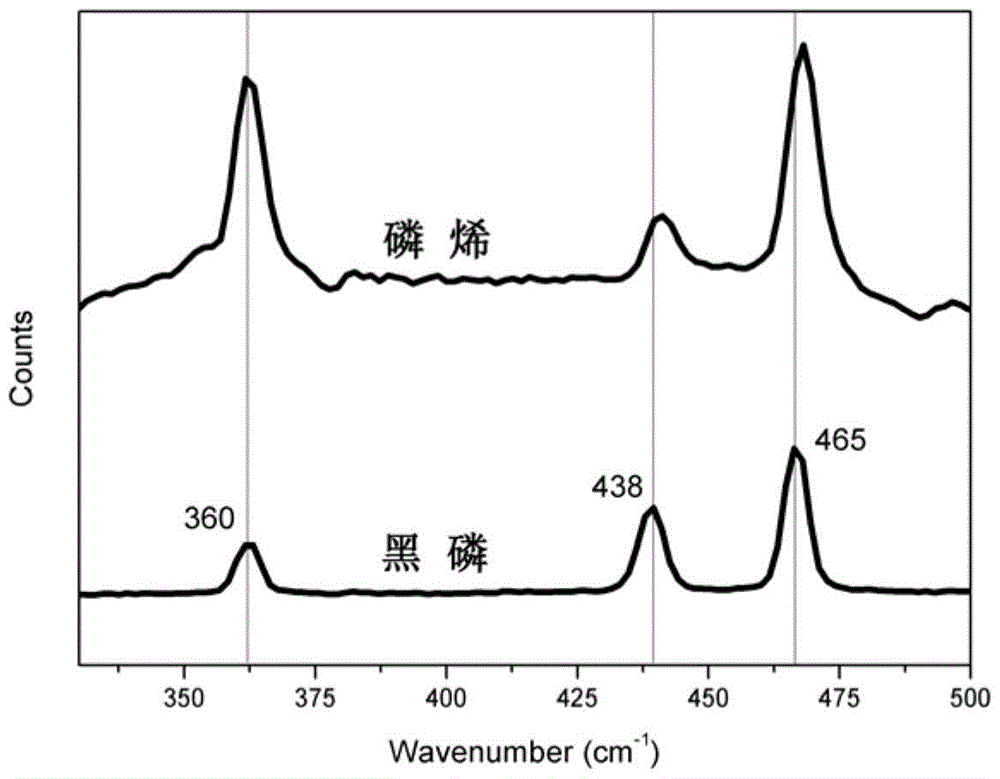A kind of method utilizing electrochemistry to prepare phosphorene
An electrochemical and phosphorene technology, applied in circuits, electrical components, electrolytic processes, etc., can solve the problems of time-consuming, cumbersome and complicated process, and difficult preparation, and achieve the effect of high yield and low cost
- Summary
- Abstract
- Description
- Claims
- Application Information
AI Technical Summary
Problems solved by technology
Method used
Image
Examples
Embodiment 1
[0038] Positive electrode: use an area of 1cm 2 , a platinum sheet with a thickness of 0.2mm was used as the positive electrode. Negative electrode: Black phosphorus is directly used as the negative electrode. In a 500ml beaker, NaPF 6 Add it into ethylene carbonate to form a 1mol / L electrolyte solution, and add 0.01g of sodium lauryl sulfate thereto. The above two electrodes were placed in parallel with a distance of 2 cm. Connect the two electrodes with wires as an electrochemical device, and apply a 15V DC voltage between the two electrodes for 20 hours.
[0039]After the exfoliation process was completed, the obtained phosphorene and unexfoliated bulk phosphorus were filtered out, washed several times with ethylene carbonate, and then vacuum-dried at 150 °C to constant weight. Add 100 mg of the obtained phosphorene and unexfoliated massive phosphorus into 20 ml of ethylene carbonate for re-dispersion by ultrasonic vibration for 1 h, the ultrasonic frequency is 15 Hz,...
Embodiment 2
[0042] Positive electrode: A platinum cylinder with a diameter of 3 mm is used as the positive electrode. Negative electrode: Black phosphorus is directly used as the negative electrode. In a 500ml beaker, NaBF 4 Add it to a mixed solution of propylene carbonate and tetrahydrofuran to form a 1mol / L electrolyte, wherein the volume ratio of propylene carbonate and tetrahydrofuran is 1:1. The above two electrodes were placed in parallel with a distance of 1 cm. Connect the two electrodes with wires as an electrochemical device, and apply a 20V DC voltage between the two electrodes for 48 hours.
[0043] After the exfoliation process was completed, the obtained phosphorene and unexfoliated bulk phosphorus were filtered out, washed with propylene carbonate several times, and then vacuum-dried at 150 °C to constant weight. Add 100 mg of the obtained phosphorene and unexfoliated massive phosphorus into 20 ml of propylene carbonate for re-dispersion by ultrasonic vibration for 2 h,...
Embodiment 3
[0045] Positive electrode: use an area of 1cm 2 , a platinum sheet with a thickness of 0.2mm was used as the positive electrode. Negative electrode: black phosphorus and nickel foam are pressed into an area of 1cm by a press 2 electrode sheet and use it as the negative electrode. During the pressing process, the pressure is kept at 15t, and the time is 3min. In a 500ml beaker, the LiPF 6 Add it into a mixed solvent of propylene carbonate and acetonitrile to make a 1.5mol / L electrolyte, wherein the volume ratio of propylene carbonate and acetonitrile is 1:1. The above two electrodes were placed in parallel with a distance of 3 cm. Connect the two electrodes with wires as an electrochemical device, and apply a 2V DC voltage between the two electrodes for 2 hours. Then increase the voltage between positive and negative to 5V. After maintaining the 5V DC voltage for 2 hours, increase the voltage to 20V and continue for 15 minutes, then apply -10V DC voltage to the positi...
PUM
| Property | Measurement | Unit |
|---|---|---|
| diameter | aaaaa | aaaaa |
| thickness | aaaaa | aaaaa |
Abstract
Description
Claims
Application Information
 Login to View More
Login to View More - R&D
- Intellectual Property
- Life Sciences
- Materials
- Tech Scout
- Unparalleled Data Quality
- Higher Quality Content
- 60% Fewer Hallucinations
Browse by: Latest US Patents, China's latest patents, Technical Efficacy Thesaurus, Application Domain, Technology Topic, Popular Technical Reports.
© 2025 PatSnap. All rights reserved.Legal|Privacy policy|Modern Slavery Act Transparency Statement|Sitemap|About US| Contact US: help@patsnap.com


